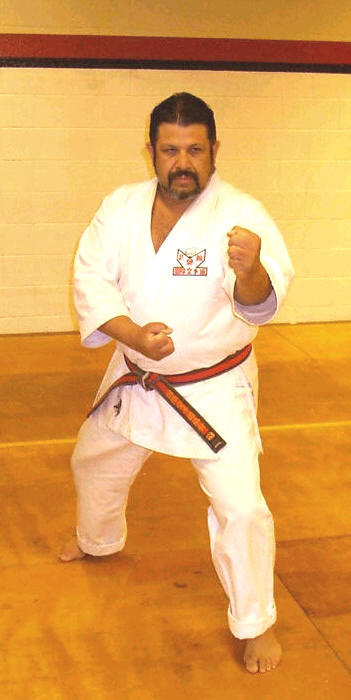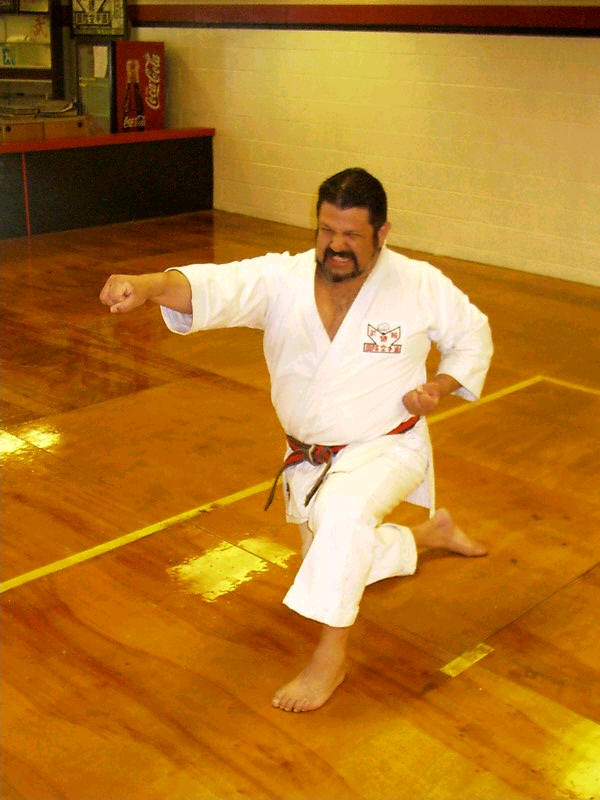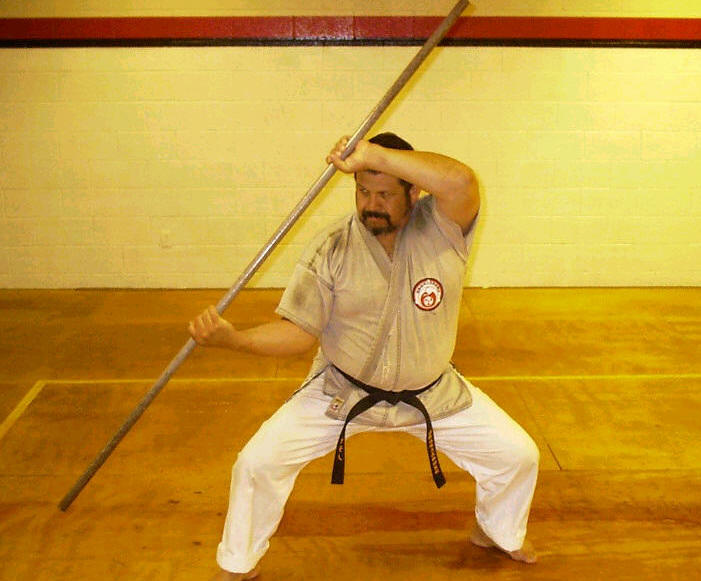
MARTIALFORCE.COM
PRESENTS
SHIHAN TOM SERRANO

AUGUST / 2003
MartialForce.com
Online Martial Arts Magazine
By Shihan Eddie Morales


Shihan Tom Serrano, head instructor for the Pasadena dojo of International Karate Association, is a member of the Board of Directors of the U.S. branch of I.K.A. and a member of the Board of Directors of Traditional Martial Arts International. Shihan Serrano was born and raised in Pasadena and is a graduate of the Pasadena City Schools. He began his karate training at the age of 13 and has devoted over 33 years to training and teaching under the tutelage of Soke Takayuki Kubota, Grandmaster. Shihan Serrano currently holds the rank of Rokudan, sixth degree black belt in Gosuku-ryu karate, as well as the rank of Sandan, third degree black belt in the art of Okinawan weapons.


Throughout the 1970s, 1980s and 1990s, Shihan Serrano repeatedly distinguished himself as both competitor and coach in local, statewide, national and international competition. After winning numerous titles in both kumite and kata, including the 1977 Ryobukai Championship, the1980 World Kubota Cup Championship, and the 1992 Alaska State Championship, Shihan Serrano served as Coach of the U.S. A. Team to the 1995 Okinawan Pre-World Tournament.
For more than 29 years, Shihan Serrano has trained and taught fighting strategies and techniques at dojo’s all over the world, helping to disseminate and maintain the methods and applications of Gosuku-ryu karate and Soke Kubota's kubotan, keychain self-defense. His fighting strategies can be found in the "World of Martial Arts" video series. Today, Shihan Serrano is one of Soke Kubota's highest-ranking instructors and is a certified kubotan instructor. Interested in broadening his knowledge of the role of healing in the martial arts, Shihan Serrano is also a professional massage therapist trained in Seifukujitsu, restorative massage, as well as sports hypnosis.
THE DOJO
The Pasadena branch of the International Karate Association, which opened in 1964, was the first U.S. branch to open. In addition to excellent martial arts instruction, this club offers the prospective student sauna, showers, fitness equipment, gravity systems, heavy bags and kicking bags.
We offer a four-phase training program at the dojo. First is physical fitness for conditioning the mind and body. Second is mental fitness, using visualization and relaxation techniques to improve concentration and build self-esteem. Third is nutritional awareness to educate students about proper diet and the use of vitamin and protein supplements which have helped many professional and Olympic athletes in achieving and maintaining a healthy energy level. The fourth facet of our training program is educational. We ask that our young students work their martial arts and regular school hand-in-hand. Consistent training combined with diligent schoolwork sharpens learning skills, improves memory and recall and instills the discipline necessary to fulfill responsibilities and achieve success in all endeavors.
1) M.Force - How long have you been practicing Karate?
Shihan Tom Serrano-A little over 37 years.
2) M.Force - What are the changes you’ve seen through the years in training?
Shihan Tom Serrano-I think because of the exposure the media gave to the martial arts there is no mystique about it these days like in the 1960’s and 1970’s and I see easy belt promotions with a lot of guys where instead of giving the quality and having the credentials to back up that rank, they are just giving the rank for the money whether the person is ready or not. That’s the stuff I have seen change .
3) M.Force - Do you still train and teach in the same manner as you did 15 years ago?
Shihan Tom Serrano-Yes, as far as the philosophy is concerned ,it’s the same and I try to get the principles across but I would say its less brutal because in the old days to block someone’s kick and bang a little bit you were proud of your wounds, nowadays every one complains.
4) M.Force - Do you find that people are attracted to martial arts training or have you noticed a decrease in martial arts practitioners and what do you think the reason for that is?
Shihan Tom Serrano- I think the over saturation of schools in certain areas like here where I am located you can see there’s several schools where they can see each other working out, one across the street from the other and I think that’s what’s been over saturated plus there’s no quality in the training anymore its just bang them out and give them there rank as opposed to make them become proficient in their technique
5) M.Force - What style do you practice and teach?
Shihan Tom Serrano-The style here of karate is referred to as Gosoku Ryu, Master Kubota developed it at a young age, he trained in Gojuryu from the ages 5 to about 11 years old then his father transferred him over to the shotokan system seeing that the kids were much stronger and by the time he was thirteen he already had the concept of Gosoku Ryu system, from the goju and the shotokan root. The actual term Go is like hard or fast So is quickness or speed Ku is like saying the many ways or the variation, the using of the force with speed and Ryu means style or system, so that the style of force or speed “Gosoku Ryu”.
6) M.Force - Why did you personally choose this style?
Shihan Tom Serrano-Well, Back in the days when I was watching it, we didn’t know about different styles, but I did know good quality teaching
When I saw it. A friend of mine was taking lessons from Tonny Tulleners, he said “this guy is really good come and try it out” and prior to that I use to watch my uncle train with a guy that was in kempo so to me I thought it was the same thing, I didn’t know their were differences .When I went in I saw the instructor was very attentive about detail , movement and technique . Back then we didn’t have privates; you just got thrown into the group. He was able to control the class, still give me my lesson and work the class at the same time. I thought someone who is that organized has something going, that’s why I enjoyed his training.
Shihan Tom Serrano-To me I think it would be “practical techniques” what I would consider street efficient .You have your sport karate but that’s not going to save your life as opposed to what has to be used out on the street and I think that’s pretty much what people are looking for “how to protect themselves” how to make sure they can come out unscaved, that’s what there looking at.
8) M.Force - Ok, I know you also practice Okinawa Kobudo, where did you learn it?
Shihan Tom Serrano-I worked with Anthony Marquez back in 1991 I wasn’t able to go train at my grand masters dojo because I would have to go to him to get the training but it was offered to me by this man, he proposed that he would come over to my dojo once a week and teach class until I got proficient enough to get my black belt and take over the lessons. I thought that was a nice offer, he was coming to me instead of me going to him, that's how we build our relationship , using the weapons itself or …for a new incentive for me and it was a good challenge.
9) M.Force - Do you teach Kobudo in your curriculum at the school?
Shihan Tom Serrano- Yes, I work with advanced weapons class on Wednesday’s and on Friday’s its beginning weapons , then on Saturday’s I have what is called the “koburobics”class,its an aerobic workout with music using weaponry.
10) M.Force - Did you develop this “Koburobics”?
Shihan Tom Serrano-Actually I helped Kyoshi Anthony Marquez with it, he came up with the understanding of it and I just kept it going and started having classes with it, so I just started making it my class on Saturday’s .it was my workout and I had people wanting to train in it so I said “come on in and train “And they started learning the weapons that way.
11) M.Force - What weapons do you practice?
Shihan Tom Serrano-I work with the Bo (six foot staff) the Tunfa (side handle baton) the Sai, Nunchaku and Jo.
12) M.Force - If you have one, which weapon one is your favorite?
Shihan Tom Serrano-Well it’s hard to say…actually Tunfa, I think Tunfa is my favorite. Between Tunfa and Sai, I like all of them I don’t like to put a preference but if I did have one I think the Tunfa is most challenging to me.
13) M.Force - Do you have a favorite weapons kata?
Shihan Tom Serrano- Actually no, I like them all. Im the type that if you have something that’s of a challenge and then you learn to keep that challenge maintained by my mastering it, to me throw anything out their from beginning kata to advanced kata just as long as I put out my best that’s what im looking for.
14) M.Force - Ok, how long have you been teaching?
Shihan Tom Serrano-I would say for Thirty Four years as an instructor, prior to that I was doing it as an apprentice greenbelt into the brown belt level .
15) M.Force - Have you ever competed in tournaments?
Shihan Tom Serrano-Oh yes! I say from the time I was fifteen years old up to forty-eight years old.
16) M.Force - What year would that be, approximately?
Shihan Tom Serrano-I would say 1968 to 1998.
17) M.Force - Do you recommend students and practitioners to compete?
Shihan Tom Serrano-Yes, but I think it should be a choice just like wanting to go test for rank, that’s something that they should choose if they want to do.
18) M.Force - What are your thoughts on kata training?
Shihan Tom Serrano-I feel it’s the backbone of fighting, I think it helps a person to stay in tune; they can practice at home or on vacation. They don’t have to be at the dojo when they work their kata’s, they can practice those anywhere because you don’t need a partner you can go at any speed or pace .You can emphasize certain things if you want to get your stances better or learn to have cleaner movements with the hands, whatever it is you can always take an aspect of it through your kata training that will help you get better at fighting.
19) M.Force - What do you think of the general public when they buy an instructional video on kata and they have never trained before? Do you think they get something out of it or is professional instruction recommended?
Shihan Tom Serrano-Well, I think if it strikes a curiosity in them more than likely there going to have some training, some exposure and when they see something that’s on video I think that they would want to come at least prepared with some of the basic fundamentals, stances, blocks so when you have something that’s brought out their on video the persons curiosity is "can I attain this," "is this something of my interest" so when you see its Chinese, Japanese, Korean if its put on video and its done well ,then that’s what I really think it is ,its just good instruction a person is going to be very proficient.
M.Force-Thank you ! Shihan Tom Serrano
Interviewed by:
M.Force Staff
![]() A PERSONAL MESSAGE FROM SHIHAN
TOM SERRANO:
A PERSONAL MESSAGE FROM SHIHAN
TOM SERRANO:
![]()
For many years the martial arts has been one of the most magnificent methods for training the mind,body,and developing the spirit. Currently however there has been a trend towards fighting and not the development of the skills necessary to "not to fight".
Weapons training,Kata and sport karate are excellent methods for learning about yourself, pushing your own limits and growing as an individual who becomes a positive element in society. As Martial Artist we have the responsibility to teach those around us and those who follow us the ways of peace, community and respect; but before we can do this, we first must teach ourselves...Join me on this journey. Thank You".
Click on the following picture's To enlarge
To Contact Shihan Tom Serrano:
:
IKA@IKAPasadena.com